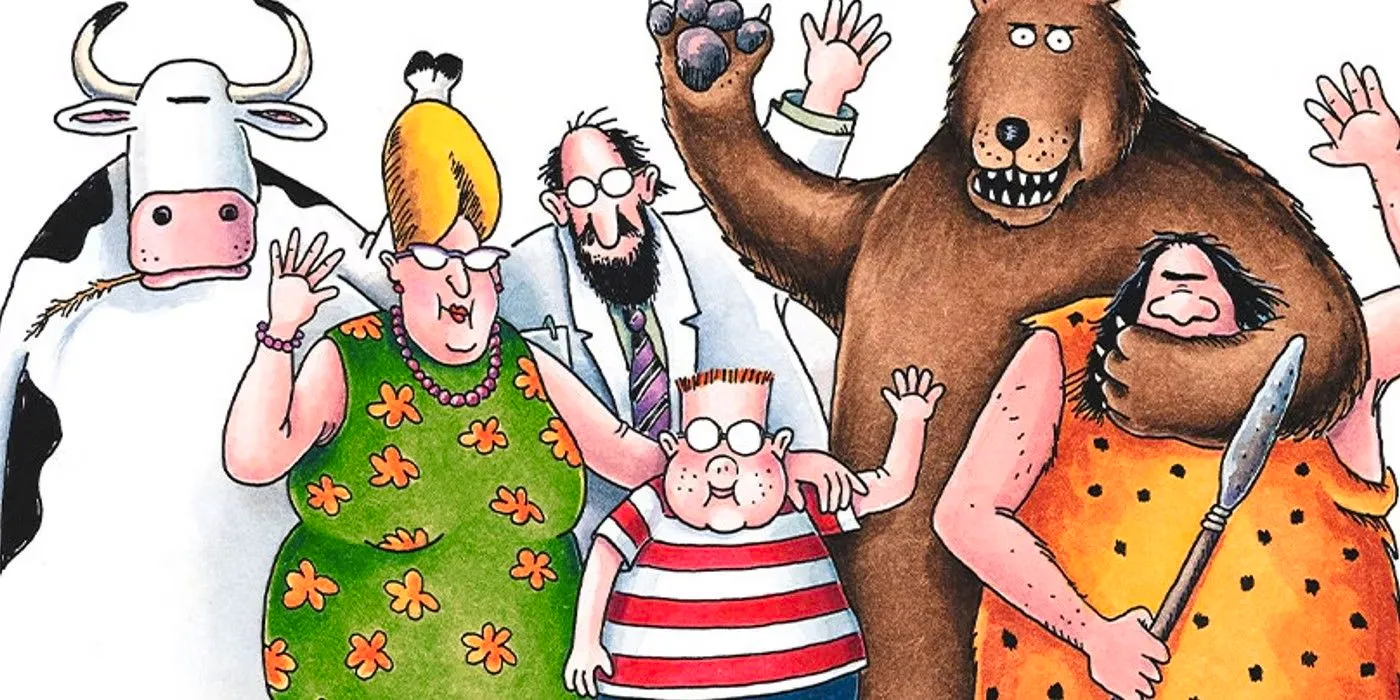Over fifty years, Doonsbury has been narrating an ongoing story.
The fact that Doonesbury mostly runs in actual time—that is, that its earliest characters, Mike Doonesbury, B.D., and Zonker Harris, have aged nearly fifty years since they were originally introduced—is among the most amazing features of the strip.
Doonesbury started off inauspiciously enough, but it quickly became well-known as a famous and highly praised newspaper Comic Strip with a social relevance focus. Originally presenting a simple narrative of the life of the titular Michael Doonesbury, a college undergraduate, Garry Trudeau's comic soon started to offer analysis of current events and political reality. More importantly, Doonesbury kept adding more cast of recurrent characters, many of whom would still show up for decades, leading increasingly complex and tragic lives that Trudeau and his artistic partners painstakingly detailed.
The Far Side featured several recurring gags but no overall plot.
Though its tenure in syndicated was very brief, by compared to Doonesbury – or other heavyweights of the form, such Charles Schulz's Peanuts and Jim Davis's Garfield - Gary Larson's The Far Side is among the most creative comics of the 20th century. Larson never dabbled in continuous narratives and avoided using recurring characters in his work. Thousands of Far Side payments were published over fifteen years; each one of these exists alone and can be appreciated by the reader apart from the history of the strip.
Gary Larson's main objective as an artist with every Far Side strip was to get his viewers to react. He frequently took familiar objects for the audience and twisted them to suit his unique viewpoint. Though Larson's art was essentially a representation of an eclectic person, with what manifested on the paper shifting radically from day, it was in a sense a collection of his obsessions and interests. Although Larson's work clearly included social critique, it was nearly always presented under the cover of dark comedy, or plain foolishness.
Both Doonesbury and The Far Side are wonderful for rather different purposes.
Though quite different, it is interesting to compare Doonesbury with The Far Side since their variances highlight what makes both works of modern art indispensable.
As Doonesbury has developed, it has brought next generations of characters who have kept open doors for modern ideas and fresh viewpoints to join the narrative. Any long-form story requires this; Doonesbury is especially valuable for study because of its special place in the history of the medium. It has occasionally been soap operatic and at other times almost a political treatise. Doonesbury is really a vast American story in how it treats the private life of its people as well as how it addresses national problems of the nation.
This Comic Strip Exactly Opposite of The Far Side (& That's What Makes It Great)
Though they share the first names of their respective creators, Gary Larson's The Far Side and Garry Trudeau's Doonesbury reflect quite distinct approaches to the Comic Strip genre. By means of a comparative study of Larson and Trudeau's works, one can get amazing understanding of how both created a significant legacy in the annals of syndicated comics.
Larson's work was existentialist and absurdist; each Far Side panel is a whole, self-contained universe unto itself, ready for appreciation apart from the rest. While Doonesbury is a realism depiction of American life, one with essentially the same cast of characters for almost half a century.
Doonesbury: A Time Chronicle
Beyond mere financial success, in 1984 Doonesbury was the first newspaper comic strip given a Pulitzer Prize in the "Editorial Cartooning" category.
One of the most intriguing features of Doonesbury is the fact that, since the 1980s, the strip has mostly been in real time, therefore the first characters, such Mike Doonesbury, B.D., and Zonker Harris, have aged about fifty years since they were first presented. More than merely aging, though; the strip's characters have changed with the years. Beginning as a Democrat-supporting liberal in the 1970s, Mike Doonesbury, for instance, plotted a road typical in American politics, first leaning more conservative over time and finally joining the Republican party.
The Legacy of the Far Side
Fans of the far side cannot miss this master collection of Gary Larson's best creations. Originally released in hardcover in 2003, this paperback collection comes replete with a newly designed slipcase that will look fantastic on any shelf. Including almost 4,000, plus more than 1,100 that have never before appeared in a book and even those made after Larson retired, the Complete Far Side features every Far Side cartoon ever published.
Gary Larson's work focused on the instantaneous reaction of the reader rather than on protracted contemplation of any one concept. He mostly opposed the search of deeper significance in his cartoons, an artistic posture putting The Far Side in diametric antithesis to Garry Trudeau's work in Doonesbury. In terms of how both stretched the boundaries of the medium in very different directions, for very different purposes, Trudeau's realism and Larson's surrealism essentially reflect two extreme extremes of the newspaper comic.



